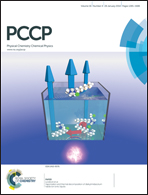Divacancies in diamond: a stepwise formation mechanism
Abstract
Diffusion of monovacancies in diamond creates various trapped multivacancy clusters. The simplest diffusion process leads to a divacancy, V2. The formation of V2 is a critical step in the formation of larger vacancy clusters. We explored the relaxed potential energy surfaces in the formation of V2 by ab initio density functional theory (DFT) obtaining structures, relative energies, diffusion barriers and reaction paths. The constricted environment of a diamond lattice leads to unexpected chemical bonding situations with unusually elongated carbon–carbon bonds that have multicenter character. Divacancies separated by one carbon are not stable. Even though the divacancy is the most stable final product, a novel isolated divacancy with two vacant sites separated by two bonded carbons [V–C![[double bond, length as m-dash]](https://www.rsc.org/images/entities/char_e001.gif) C–V] can be transformed into a divacancy only via a very large (>4.3 eV) barrier and therefore it should be a defect observable in irradiated diamonds. Trapping of a vacancy by another by forming a stable divacancy trap affects the development of NV-defects in nitrogen implanted diamonds that are subject to active current interest in a wide range of applications.
C–V] can be transformed into a divacancy only via a very large (>4.3 eV) barrier and therefore it should be a defect observable in irradiated diamonds. Trapping of a vacancy by another by forming a stable divacancy trap affects the development of NV-defects in nitrogen implanted diamonds that are subject to active current interest in a wide range of applications.


 Please wait while we load your content...
Please wait while we load your content...